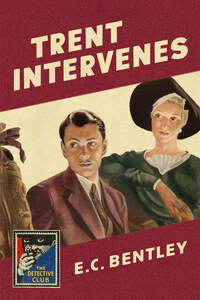‘THE DETECTIVE STORY CLUB is a clearing house for the best detective and mystery stories chosen for you by a select committee of experts. Only the most ingenious crime stories will be published under the THE DETECTIVE STORY CLUB imprint. A special distinguishing stamp appears on the wrapper and title page of every THE DETECTIVE STORY CLUB book—the Man with the Gun. Always look for the Man with the Gun when buying a Crime book.’
Wm. Collins Sons & Co. Ltd., 1929
Now the Man with the Gun is back in this series of COLLINS CRIME CLUB reprints, and with him the chance to experience the classic books that influenced the Golden Age of crime fiction.
COLLINS CRIME CLUB
An imprint of HarperCollinsPublishers Ltd
1 London Bridge Street
London SE1 9GF
www.harpercollins.co.uk
First published in Great Britain by Thomas Nelson and Sons 1938
‘Meet Trent’ first published by George Allen & Unwin Ltd 1935
‘The Ministering Angel’ first published in The Strand 1938
Introduction first published by Alfred A. Knopf, Inc. 1953
Copyright © Estate of E. C. Bentley 1935, 1938
Jacket design © HarperCollinsPublishers Ltd 1938, 2017
A catalogue copy of this book is available from the British Library.
This novel is entirely a work of fiction. The names, characters and incidents portrayed in it are the work of the author’s imagination. Any resemblance to actual persons, living or dead, events or localities is entirely coincidental.
All rights reserved under International and Pan-American Copyright Conventions. By payment of the required fees, you have been granted the non-exclusive, non-transferable right to access and read the text of this e-book on screen. No part of this text may be reproduced, transmitted, down-loaded, decompiled, reverse engineered, or stored in or introduced into any information storage and retrieval system, in any form or by any means, whether electronic or mechanical, now known or hereinafter invented, without the express written permission of HarperCollins.
Source ISBN: 9780008216290
Ebook Edition © August 2017 ISBN: 9780008216306
Version: 2017-06-27
A LITTLE more than four decades ago, in the dear, dead year of 1910, when world wars were still unknown and the Edwardian age was dying with its king, Edmund Clerihew Bentley, a journalist on the staff of London’s Daily News, surveyed the state of the detective story and found it foul. But perhaps foul is too strong a word to use in connection with a polite man and a polite era; perhaps it would be better to say, simply, that Bentley found the state of the detective story unsatisfactory. He was not alone. As early as 1905 a contributor to the Academy had declared that ‘the detective in literature’ was ‘passing into decay’ and was carrying ‘with him the regret of a civilized world’.
Conan Doyle, the old master, was still very much alive as a man, with twenty years to go; but, although he was to produce three more volumes of Sherlock Holmes stories, he was pretty well done as a writer, and his imitators, who came swarming into print after 1891, had proved themselves far better able to copy the master’s faults than to match his virtues. Hence E. C. Bentley’s disgust. Hence his determination to do something about it.
Others, indeed, were already doing something in their several ways. R. Austin Freeman’s detective, Dr John Thorndyke, making his debut in The Red Thumb Mark (1907), had introduced genuinely scientific methods of detection into fiction. Baroness Orczy’s Old Man in the Corner had already taken his seat in the ABC tea shop and begun to unravel crimes while his fingers knotted and untied a piece of string. One of the Sûreté’s most famous sleuths, Monsieur Hanaud, creation of A. E. W. Mason, was just beginning his career. And Bentley’s dear friend, Gilbert K. Chesterton, had already started Father Brown on his amazing, fantastic journeys of detection, in which improbably brilliant guesses were destined repeatedly to cut straight to the core of quite impossible mysteries.
But Bentley had ideas of his own. He wished to write a full-length detective novel in which the protagonist would be ‘recognizable as a human being’. He wished also to get away from the solemnity that would have made Holmes himself insufferable, had it not been for his creator’s ingenuity, and that did make insufferable the imitations of Holmes. After all, why shouldn’t a fictional detective have his lighter side? ‘Even Mr Gladstone,’ the Fleet Street journalist reminded himself, ‘had manifested, at rare intervals, something that could only be described as a sense of humour.’









